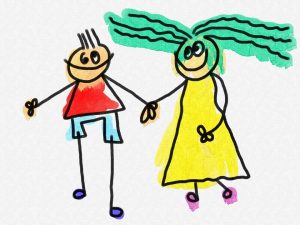relationshipsinchildhood
 A human newly born will die if others don’t take care of it: it is completely dependent on caregivers. This does not mean that the baby is passive or blank; on the contrary, it actively strives, by means of crying, cooing, eye, hand and body gestures, to get its share of company, food, interesting stimuli, a clean diaper, an ending to pain or discomfort.
A human newly born will die if others don’t take care of it: it is completely dependent on caregivers. This does not mean that the baby is passive or blank; on the contrary, it actively strives, by means of crying, cooing, eye, hand and body gestures, to get its share of company, food, interesting stimuli, a clean diaper, an ending to pain or discomfort.
The mother interprets the baby’s wordless language and acts upon that interpretation. Thus the relationship between mother and child may be said to be complementary. Both are dependent on each other. Both want and need each other. The mother is as much a slave to the baby as the baby is an object of care to her. When it comes to survival, the baby even has an edge, because it is interested in nothing but its own survival. So the child may be said to use its mother to further its own career, just as the mother had the baby because she wanted it for herself. Dependency is thus a very general social fact: everybody depends on everybody for their own benefit or survival. In that sense everybody has a relationship with everybody.
 Attachment
Attachment
If we wish to understand personal or intimate relationships, it is better to start from the concept of ‘attachment’. We can follow a child in its development and recognize ourselves.
When a baby is born, its mother needs only a few hours or days to get ‘attached’ to it. The baby, however, is not yet able to recognize the people around her/him. It takes about a year before it has learned to recognize the faces it has seen on a daily base. From that time on it will smile when it sees its mother or father and turn away or look with intense curiosity at faces that are new. That is when the attachment to the caregiver(s) starts, and it continues to strengthen for years after that. The mother is happy with the child, she holds it, feeds it, rocks it, sings for it, plays with it, tries to makes it smile and talk. The child experiences her presence as pleasant and when she leaves the room the child looks around till she comes back. When she stays away longer, the child becomes restless and starts to call her. When she doesn’t come back, the child becomes angry and may start to cry. When she finally returns, the child can’t forget its anger and desperation right away and it takes some effort on the side of the mother to regain its trust. When the mother stays away very long, the child will become alarmed and cry till it almost chokes. If the mother doesn’t come back at all, the child will stop crying with exhaustion, then become depressive and mourn the loss.
This attachment pattern is universal and originates in our evolutionary history. Our ancestors lived in a world of continuous danger, where little children were easy catches for prey animals and had to stay close to grown-ups for their protection. Scaremongering thus became an accepted feature of upbringing. The present modern world offers many people a much more secure living environment, which has created criticism of the old fear-inspired upbringing and education. However, in our world too, some dangers are still real enough (electricity, heat, substances, traffic) to activate the motherly protective and restrictive attitude which shapes early childhood. Fantasized or exaggerated dangers, too, still play a considerable part in upbringing.
The need of a stable relationship
The strong need of small children for a stable relationship with a caregiver lies at the heart of the intimate relationships in later life. It has also created a lot of psychology to explain why most relations are problematic and conflict-ridden, why some individuals do better than others, or why there is so much mistrust, suspicion, aggression, jealousy especially between those to whom we are closest. A standard distinction made is between individuals inclined to have either ‘secure’ or ‘insecure’ attachments, depending on the quality of mothering that they have received as children. This has promoted the idea of a division between ‘good’ and ‘bad’ families, the former producing happy people with happy families of their own, the latter producing lonely, depressed, unsuccessful, overweight, drug or alcohol abusers. The truth is that most attachments are insecure. The reason is that no mother is fully available to give the child all the love and attention it needs. Mothers are themselves children in need of care, which they demand from the father. They are also (insecurely) attached to the child. And besides loving the child, they also have to train and correct, warn and punish it, in short, be a repressive and controlling force. Conflicts are inevitable.
Sexual desire
Apart from attachment, which explains how we love like a child, care giving and sexual desire play a fundamental role in intimate relations. Care giving is complementary to attachment: it explains how we love like a parent. Sexual desire develops in early childhood and is first directed towards one of the parents, later to individuals outside the family. Mixed with attachment and care, the sexual feelings in adolescence create an explosive mixture of love and conflict, which predictably leads to exclusive partnerships in procreation and new families, where history repeats itself.
